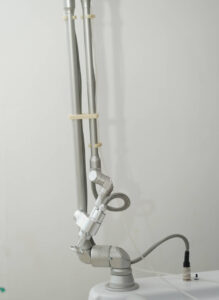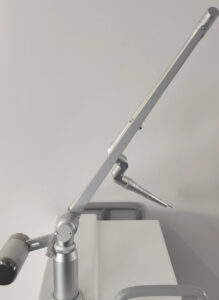In the world of modern aesthetic treatments, laser beauty machines are essential tools used for procedures such as skin resurfacing, pigmentation removal, hair reduction, and scar treatment. While much of the attention goes to the laser itself, one critical component often overlooked is the artificial arm. This mechanical extension plays a vital role in delivering precise and consistent energy during treatment sessions.
In this article, we’ll explore the function, types, and advantages of artificial arms used in laser aesthetic machines, helping clinic owners, technicians, and users better understand this important part of the system.
What Is an Artificial Arm in Laser Beauty Machines?
The artificial arm, sometimes referred to as a laser articulated arm or mechanical delivery arm, is a system of interconnected joints and mirrors used to deliver laser energy from the source to the handpiece with minimal loss and maximum precision. Think of it as the bridge between the laser generator and the skin contact point.
Unlike a simple cable or fiber delivery system, the articulated arm is designed to maintain stable energy output, even during complex movements and treatments on different body areas.
Key Functions of the Artificial Arm
- Laser Energy Transmission
The main job of the artificial arm is to transmit laser beams with minimal energy loss. Inside the arm are multiple high-reflectivity mirrors that direct the laser beam through the joints to the treatment handpiece. - Flexible Movement
The articulated structure allows the operator to move freely across the treatment area. Whether it’s a face contour, neck area, or body region, the artificial arm enables easy access without straining the operator’s wrist or hand. - Energy Stability and Accuracy
High-end artificial arms are designed to maintain consistent energy output by minimizing laser attenuation. This ensures safe, effective, and repeatable treatments, even over long sessions. - Ergonomic Design
By taking the weight off the user’s hand, the arm improves ergonomics and reduces fatigue. This is particularly important in high-precision tasks such as fractional laser skin resurfacing or tattoo removal.
Types of Artificial Arms in Laser Beauty Machines
Depending on the internal balancing mechanism and structural design, artificial arms are commonly divided into two types:
1. Torsion Spring-Balanced Arms
This is the most commonly used type in medical aesthetic devices. Each joint in the arm is equipped with a torsion spring that counterbalances the weight of the arm segments and the handpiece. As the user moves the handpiece, the springs provide resistance and support, maintaining balance and ease of use.
Advantages:
- Lightweight and easy to operate
- Smooth, responsive movement in all directions
- Affordable and widely adopted in dermatology and aesthetic devices
- Good for delicate, repetitive treatments such as fractional resurfacing
Disadvantages:
- Springs may weaken over time and require replacement
- Slight vibration or mechanical backlash may occur if the arm is poorly maintained
Typical Applications:
- CO₂ fractional lasers
- Vaginal rejuvenation systems
- Skin resurfacing devices
2. Counterweight-Balanced Arms
This design uses physical counterweights placed at strategic points in the arm to balance the handpiece. The force of gravity is used to stabilize the arm’s movements, making it ideal for heavier equipment or when higher resistance is required for control.
Advantages:
- Excellent stability during long procedures
- Less prone to spring fatigue
- Ideal for precise laser surgeries or when heavy accessories are attached
Disadvantages:
- Heavier overall system weight
- Bulky, with reduced agility for fine or quick movements
- More difficult to install or transport
Typical Applications:
- Surgical CO₂ lasers in ENT or gynecology
- High-power dermatological systems
- Industrial or heavy-duty medical lasers
Why Artificial Arms Matter in Laser Aesthetics
Although it might seem like a technical detail, the design and quality of the artificial arm can directly impact the treatment experience and clinical results.
- Treatment Precision
Poorly designed arms can cause energy loss, misalignment, or instability. High-quality arms ensure each pulse of energy hits the intended target with consistent power. - Safety
Stable energy transmission reduces the risk of burns, under-treatment, or damage to surrounding skin. - Operator Comfort
An ergonomic, well-balanced arm reduces hand fatigue and makes it easier to perform treatments with focus and accuracy. - Longevity of the System
A reliable artificial arm reduces wear and tear on the system and minimizes maintenance downtime, saving money for clinics in the long run.
Choosing the Right Artificial Arm for Your Laser System
When shopping for a laser beauty machine or evaluating a system, pay attention to the specifications of the artificial arm. Key points to consider include:
- Mirror coating material (gold, silver, dielectric – affects reflection efficiency)
- Arm flexibility and range of motion
- Material and weight
- Ease of maintenance
- Compatibility with your handpieces and treatments
Leading laser manufacturers often highlight their arm systems as a core selling point. Look for brands that have a reputation for precision engineering and long-term durability.
Conclusion
The artificial arm in a laser beauty machine might be hidden in plain sight, but its impact on treatment results, safety, and user comfort is undeniable. Whether you are a clinic owner, technician, or distributor, understanding the function and types of these articulated arms can help you make better decisions and improve treatment outcomes.
When selecting a laser aesthetic system, don’t just focus on the laser type or software—check the quality of the artificial arm, and ensure it supports your practice’s needs for flexibility, precision, and long-term performance.


